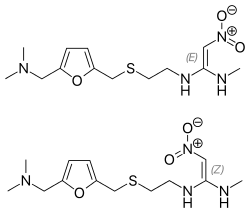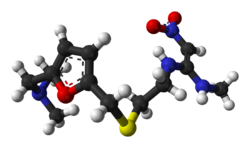Ranitidine
 |
|
 |
|
| Clinical data | |
|---|---|
| Pronunciation | /rəˈnɪtᵻdiːn/ |
| Trade names | Zantac, others |
| AHFS/Drugs.com | Monograph |
| MedlinePlus | a601106 |
| License data |
|
| Pregnancy category |
|
| Routes of administration |
Oral, IV |
| ATC code |
A02BA02 (WHO) A02BA07 (WHO) (ranitidine bismuth citrate) |
| Legal status | |
| Legal status |
|
| Pharmacokinetic data | |
| Bioavailability | 39 to 88% |
| Protein binding | 15% |
| Metabolism | Hepatic: FMOs, including FMO3; other enzymes |
| Biological half-life | 2–3 hours |
| Excretion | 30–70% Renal |
| Identifiers | |
|
|
| Synonyms | Dimethyl [(5-{[(2-{[1-(methylamino)- 2-nitroethenyl]amino}ethyl)sulfanyl] methyl}furan-2-yl)methyl]amine |
| CAS Number |
66357-35-5 |
| PubChem (CID) | 3001055 |
| IUPHAR/BPS | 1234 |
| DrugBank |
DB00863 |
| ChemSpider |
4863 |
| UNII |
884KT10YB7 |
| KEGG |
D00422 |
| ChEBI |
CHEBI:8776 |
| ChEMBL |
CHEMBL1790041 |
| ECHA InfoCard | 100.060.283 |
| Chemical and physical data | |
| Formula | C13H22N4O3S |
| Molar mass | 314.4 g/mol |
| 3D model (Jmol) | Interactive image |
|
|
|
|
|
|
|
Ranitidine, sold under the trade name Zantac among others, is a medication that decreases stomach acid production. It is commonly used in treatment of peptic ulcer disease, gastroesophageal reflux disease, and Zollinger–Ellison syndrome. There is also tentative evidence of benefit for hives. It can be taken by mouth, by injection into a muscle, or into a vein.
Common side effects include headaches and pain or burning if given by injection. Serious side effects may include liver problems, a slow heart rate, pneumonia, and the potential of masking stomach cancer. It is also linked to an increased risk of Clostridium difficile colitis. It is generally safe in pregnancy. Ranitidine is an H2 histamine receptor antagonist that works by blocking histamine and thus decreasing the amount of acid released by cells of the stomach.
Ranitidine was discovered in 1976 and came into commercial use in 1981. It is on the World Health Organization's List of Essential Medicines, the most effective and safe medicines needed in a health system. It is available as a generic medication. The wholesale price in the developing world is about 0.01 to 0.05 USD per pill. In the United States it is about 0.05 USD per dose.
Certain preparations of ranitidine are available over the counter (OTC) in various countries. In the United States, 75- and 150-mg tablets are available OTC. Zantac OTC is manufactured by Boehringer Ingelheim. In Australia and the UK, packs containing seven or 14 doses of the 150-mg tablet are available in supermarkets, small packs of 150-mg and 300-mg tablets are schedule 2 pharmacy medicines. Larger doses and pack sizes still require a prescription.
...
Wikipedia
